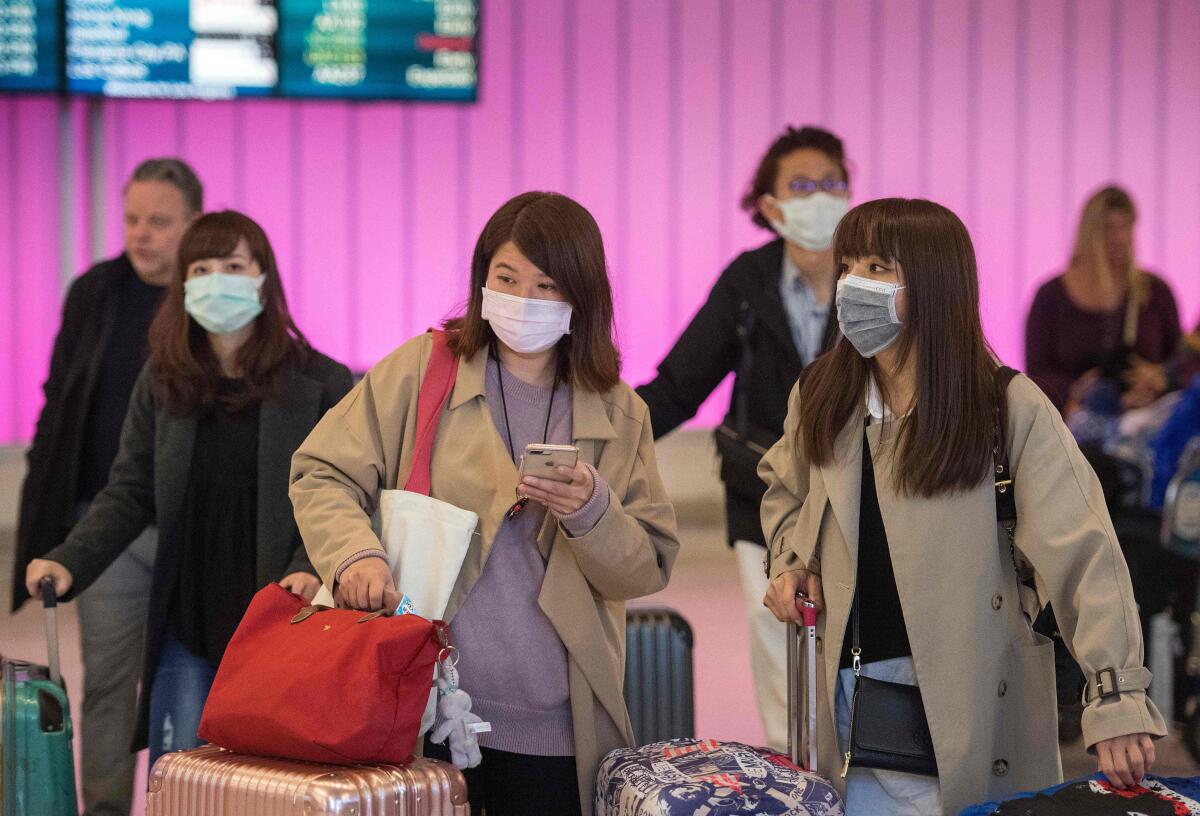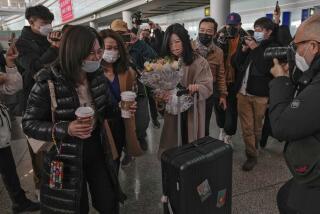World health leaders oppose coronavirus-related travel restrictions. Airlines cut 25,000 flights anyway

- Share via
Amid the growing fear over the coronavirus outbreak, nearly 40 airlines worldwide have cut about 25,000 flights to, from or within China compared with two weeks ago.
More than 500 flights a month between the U.S. and China have been temporarily suspended despite urging by the World Health Organization against travel and trade restrictions because of the virus outbreak that started in China, infecting at least 20,000 people and killing more than 400 people.
Airlines that range from the world’s largest, American Airlines, to small carriers like Turkmenistan Airlines are eliminating some or all service to mainland China, representing one of the biggest blows to international travel in many years.
“The response like this to such a business travel focused nation is a big deal,” said Hayley Berg, economist for the travel site Hopper. She noted that China has in the last few years become a big source of heavy-spending international tourists and a center for business travel.
During the Lunar New Year celebration, the U.S. was expected to host 175,500 Chinese travelers, with Los Angeles receiving about 50,000 of those visitors, according to Hopper.
Although international carriers are expected to suffer an economic blow, industry experts say an analysis of previous outbreaks shows that international air demand eventually returns to normal within a few months of an episode.
During the 2003 severe acute respiratory syndrome, or SARS, viral outbreak, airlines in Asia lost about $6 billion in revenue but demand for air travel to the region rebounded seven months after the crisis began, according to the International Air Transport Assn.
In a statement, John Grant, senior analyst with OAG Aviation, an international flight data company, called the latest cuts in flights “probably the most significant ever seen in one week in response to any pandemic event.”
According to OAG, the reduction in flights to, from and within China represents 4.4 million fewer airline seats, with the biggest hit being felt by Chinese airlines that operate domestic flights. Carriers such as China Eastern Airlines and Air China are enduring cuts to capacity of 20% to 30% because of the outbreak, according to OAG.
In the U.S., about 1,360 flights a month operate between U.S. cities and China, with 556 of those routes operated by U.S. carriers, according to OAG. Travel from the U.S. to China alone represented 4.6% of all the U.S. international flight capacity.
Since the outbreak, demand for flights from the U.S. to China dropped by as much as 58%, Berg said.
American Airlines halted all flights to mainland China last week while its largest rivals, United Airlines and Delta Airlines, delayed the temporary suspension of all flights to mainland China until this week.
Air fares from the U.S. to China have been relatively cheap over the last few months, ranging between $675 to $700 for a round-trip economy ticket, according to several travel websites.
“There are so many flight options to China from most major U.S. cities, especially the West Coast, that it’s often one of the cheapest international destinations you can book,” said Tracy Stewart, content editor at the airfare comparison site Airfarewatchdog.
But prices began to surge as new flight restrictions were announced and foreigners in China felt the urgency to leave, sending fares up 11% between Jan. 31 and Feb. 3, Berg said.
“The bump in price is not totally unexpected to me,” she said.
Carriers from around the globe have canceled most or all flights to mainland China, either because of a sudden drop in demand or in response to government restrictions.
Last week, the Trump administration declared the outbreak a public health emergency, barring foreign nationals who recently visited mainland China from entering the U.S., and imposing a 14-day quarantine on American citizens returning from the country. Exceptions will be made for foreign nationals who are immediate family members of American citizens and permanent residents.
In a statement issued Jan. 30, the World Health Organization said it does not recommend trade or travel restrictions adding that “countries are cautioned against actions that promote stigma or discrimination.”
Still, U.S. health officials announced that all flights from China to the U.S. will also be “funneled” to 11 airports where enhanced public health screenings will be required for Americans returning from China.
Those airports include Los Angeles International, San Francisco International, New York’s JFK, Chicago’s O’Hare, Honolulu International, Seattle-Tacoma International and Atlanta Hartsfield-Jackson International.
El Al Israel Airlines said on Jan. 30 that it was suspending flights to Beijing until March 25, according to the Associated Press. Israel’s Health Ministry said it won’t allow flights from China to land at its airports.
Air France said on Jan. 30 it suspended all scheduled flights to and from mainland China until Sunday.
Germany’s Lufthansa said on Jan. 29 it was suspending Lufthansa, Swiss and Austrian Airlines flights to and from mainland China until Sunday.
More to Read
Inside the business of entertainment
The Wide Shot brings you news, analysis and insights on everything from streaming wars to production — and what it all means for the future.
You may occasionally receive promotional content from the Los Angeles Times.











